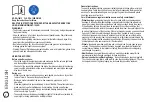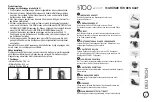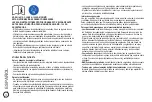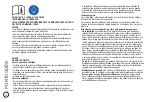
6
ENGLISH
NF-EN-14619 CLASS A 100KG MAX
Keep the instructions for future.
READ THE INSTRUCTIONS PROVIDED BY THE MANUFACTURER BEFORE
USING. MAXIMUM WEIGHT: 100 KG
WARNINGS
- The Scooter is reserved for adolescents and adults. It is not a toy, but sports equipment
for physical training.
- Use with caution on a flat, clean, dry surface and, if possible, away from other users,
and obey the road safety rules.
- Check local laws regarding scooter use, respect all the traffic rules and signs. Stay
away from other pedestrians or users on public roads.
- Best when used on a flat, dry surface free of gravel and grease. Avoid bumps and
drainage grates that might cause an accident.
- Warning! Personal Protective equipment should be worn: wrist protectors, gloves, knee
pads, helmets and elbow pads should be worn.
USING THE SCOOTER
Before and after each use:
- Check the height of the steering system and make sure that the nuts are tightened
and the handlebars and front wheel are perpendicular.
- Check all of the connection elements: the brake, the release system of the steering
column and the wheel axles must be correctly adjusted and must not be damaged
- Also check the tire wear.
During use:
- Standing on the scooter, with one hand on each handle, push with one of your feet
to move forward. Proceed with caution at the start.
- Braking: a brake is located at the rear, when necessary, press down on it to
slow down.
Press down gradually to prevent skidding or loss of stability. The metal or aluminum
brake may heat up after multiple uses. Avoid touching it during and after use.
- Shoes are mandatory and we strongly recommend wearing pants and long sleeve
shirts to avoid injury if you fall.
- The scooter does not include any headlights or lights. It is therefore not suitable for
use at night or during periods when visibility is limited.
General instructions
To use with suitable protective equipment, including a helmet, shoes, elbow, wrist and
knee protectors. Teach the child how to use it safely and responsibly. Before and after
each use: To prevent pinched fingers, don’t get your fingers stick underneath plastic
head tube cover and front fork.
Care / Maintenance: regular maintenance is a safety commitment;
- Wheel bearings
: avoid going through water, oil or sand as this can damage wheel
bearings.To look after the wheel bearings, systematically check that the wheels turn
properly by turning the scooter upside-down and using your hand to spin the wheels.
if the wheels do not spin they must then be removed to check their condition. first
unscrew the wheel axle, remove the axle and detach the wheel, then carefully push the
two wheel bearings out of their housing. if they are chipped or dented, new ones should
be bought. if there is no visible damage, they must then be oiled. to do this, remove
all traces of grease, mud or dust with a kitchen towel or cloth, and re-oil them with a
grease spray or by leaving them to soak overnight in oil [turn them several times in the
oil first]. then reassemble the wheel bearings and axles, followed by the wheel, onto the
scooter. proceed in the same manner for the other wheel.
- Wheels
: the wheels wear down with time and can be pierced if overly used on rough
surfaces. The back wheel on which the brake is applied is particularly affected after
several hours of braking. In the interests of safety, they should be checked regularly
and changed if necessary.
- Modifications
: the original product must by no means be modified except for the
maintenance-related changes mentioned in these instructions.
-
Nuts, axles and other self-locking fixings
: these should also be checked regularly.
They can become loose after a while in which case they should be tightened. They can
become worn and not tighten properly, in which case they should be replaced.
Summary of Contents for 470-100
Page 1: ...i TOO FIX UP MY 6 100kg MAX EN 14619 CLASS A T H E W O R L D O N W H E E L S...
Page 2: ...2...
Page 26: ...26 NF EN 14619 A 100 100 2 K n n...
Page 28: ...28 NF EN 14619 A 100 100...
Page 38: ...38 NF EN 14619 A 100 100 2...
Page 44: ...44 NF EN 14619 CLASS A 100 KG MAX 100...
Page 47: ...47 100 NF EN 14619 100...







































